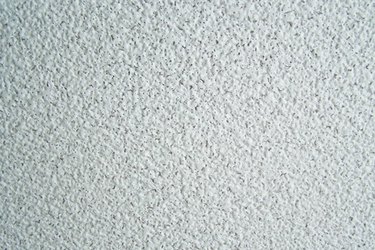Things You'll Need
Stiff-bristled brush
Spray ceiling patch
Vacuum
Thick-nap roller pad
Paint roller
Paint
Paintbrush

Textured ceilings are difficult to fix because if you try to scrape away peeling paint, the texture can come away with it. Peeling paint can often be caused by moisture problems or extreme climate changes, so fix any problems that were causing the paint to peel before attempting to fix the paint itself or it will likely just peel again. This is often accomplished by either insulating the attic above the ceiling or installing ventilation in that attic. A local contractor can help you assess what is causing the paint to peel, and once the cause is fixed, you can easily take care of the ceiling.
Step 1
Scrub the area where the paint is peeling with a stiff-bristled brush. Rub in circles to rid the ceiling of all loose paint and smooth any peeling edges. Don't worry if some of the texture comes off along with the paint.
Video of the Day
Step 2
Shake a can of textured spray ceiling patch and spray it onto the affected area. Spray around the area as well to blend with the surrounding texture. Textured ceiling sprays are available at most major home improvement stores and some paint stores. For white ceilings, the spray may be all you need. Many stores have a variety of textures available.
Step 3
Vacuum the entire ceiling using the hose attachment of your vacuum to remove any loose texture, dust and cobwebs.
Step 4
Place a roller pad with 1/2 inch or thicker nap on a paint roller and use it to paint the entire ceiling to ensure a uniform color if the spray patch did not match your ceiling paint. To reach the corners where the roller won't fit, dab the paint onto the texture with a paintbrush rather than brushing it on. This allows the bristles to reach into the gaps around the texture.
Video of the Day